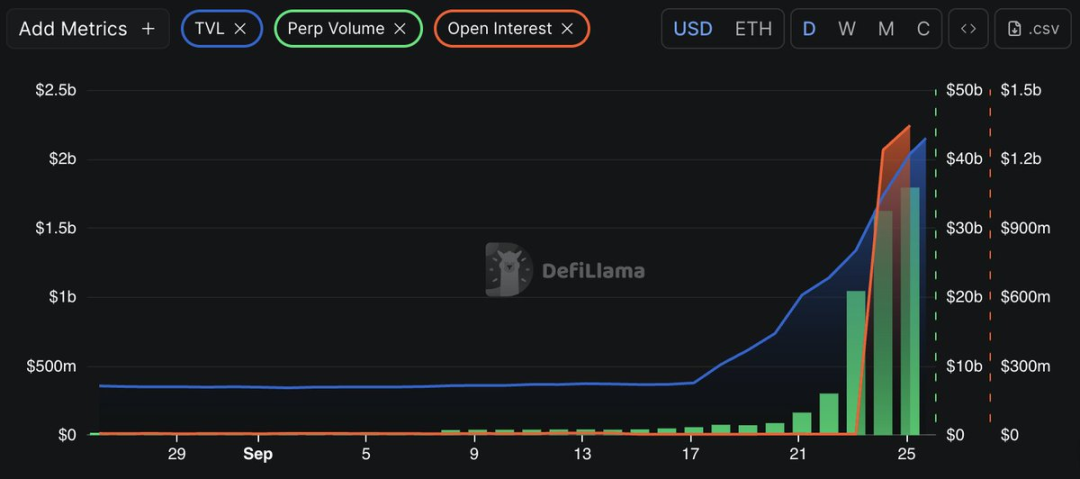Author: DeFi Warhol
Translated by: Saoirse, Foresight News
In the past week, I conducted an in-depth investigation into the surge in trading volume on the Aster platform and compared it with the Hyperliquid platform. The findings clearly indicate that the increase in Aster's trading volume is not organic growth, but rather the result of artificially inflated trading volume, wash trading (creating false trading activity through self-buying and self-selling), and coordinated manipulation.
Here are my analytical points.
Why I Conducted This Investigation
From September 16 to 23, 2025, Aster's daily trading volume skyrocketed from $1 billion to $20 billion in just 7 days, which immediately raised my suspicions. A 20-fold increase, even surpassing the fastest growth rates of all compliant DeFi platforms I have tracked.
At the same time, Aster's open interest (OI) surged approximately 33 times (from $3.7 million to $1.3 billion on September 24), and the total value locked (TVL) increased by about 500% within 30 days. In contrast, Hyperliquid's metrics showed stable organic growth during the same period.

The scale, timing, and speed of Aster's growth compelled me to investigate: are we witnessing a genuine explosive growth in platform users, or is it the result of manipulation?
Abnormal Trading Volume
Aster platform data on September 17:
- Trading volume: $1.1 billion
- Total value locked (TVL): $378 million
- Open interest (OI): $3.62 million
Aster platform data on September 24:
- Trading volume: $32 billion
- Total value locked (TVL): $1.7 billion
- Open interest (OI): $1.2 billion
In contrast, Hyperliquid maintained a relatively stable trading volume pattern during the same period. The stability of Hyperliquid's trading volume highlights the artificial nature of Aster's trading volume surge.
Organic trading volume growth typically follows the user adoption curve (i.e., a gradual increase in user numbers) and is associated with fundamental optimizations of the platform's underlying protocol. However, neither of these points sufficiently explains Aster's rapid rise.
Characteristics of Large Transfers and Wash Trading
- In the past 7 days, the platform recorded 156 large transfers exceeding $10 million, with an average transfer size of $45.2 million, which is far above typical DeFi trading levels.
- On September 25, FalconX completed 8 transfers totaling $680.4 million within 6 hours. Analysis of the transfer patterns indicates coordinated operations between the exchange and unknown wallet addresses, with the timing perfectly aligning with Aster's trading volume surge.
- On September 24, within 3 hours, 7 USDT transfers totaling $877.67 million were initiated from Binance to Aave, occurring just before Aster's trading volume spike. This temporal correlation, combined with the systematic characteristics of the transfers, suggests organized liquidity manipulation aimed at artificially inflating trading metrics.
Fee and Revenue Structure
Data from DeFiLlama corroborates my suspicions:
- 24-hour fee revenue: $12.03 million
- 30-day fee revenue: $27.9 million
- Total value locked (TVL): $2.2 billion
From this, it can be calculated that Aster's daily fee revenue to total value locked ratio is approximately 0.55%, which is 14 times that of Hyperliquid (approximately 0.04%).
More critically, Aster can only convert 59% of its fee revenue into net income, while Hyperliquid's fee conversion efficiency is around 99%. This discrepancy indicates that Aster's fee revenue largely stems from artificial circular trading (i.e., generating false fees through repeated buying and selling), rather than sustainable income from real traders.
Point System
Additionally, Aster has introduced a point system that awards points based on user trading activity and volume.
The key issue with this system is that it directly provides users with an incentive to inflate trading volume:
- Wash traders can now not only extract fees through circular trading but also earn points to redeem rewards by inflating trading volume;
- This system essentially uses "user loyalty" as a pretext to legitimize circular trading (i.e., false trades with no actual capital flow);
- The timing of the point system's introduction coincides with the peak of Aster's suspicious growth, indicating that the design of this system aims to perpetuate manipulative behavior and provide a rationalization for it.
My Conclusion
Aster's growth is not organic, primarily based on the following:
- Daily trading volume surged 20-fold within 7 days;
- Open interest increased 33 times;
- Daily fee revenue reached $12 million, but the net income conversion rate is extremely low;
- Highly reliant on the Binance Smart Chain (BSC), with cross-chain wash trading cycles (i.e., creating trading volume through false trades across different blockchain networks);
- The point system further amplifies the motivation for manipulation.
In summary, Aster's growth is a coordinated manipulation effort rather than genuine user acceptance and business growth.
免责声明:本文章仅代表作者个人观点,不代表本平台的立场和观点。本文章仅供信息分享,不构成对任何人的任何投资建议。用户与作者之间的任何争议,与本平台无关。如网页中刊载的文章或图片涉及侵权,请提供相关的权利证明和身份证明发送邮件到support@aicoin.com,本平台相关工作人员将会进行核查。


